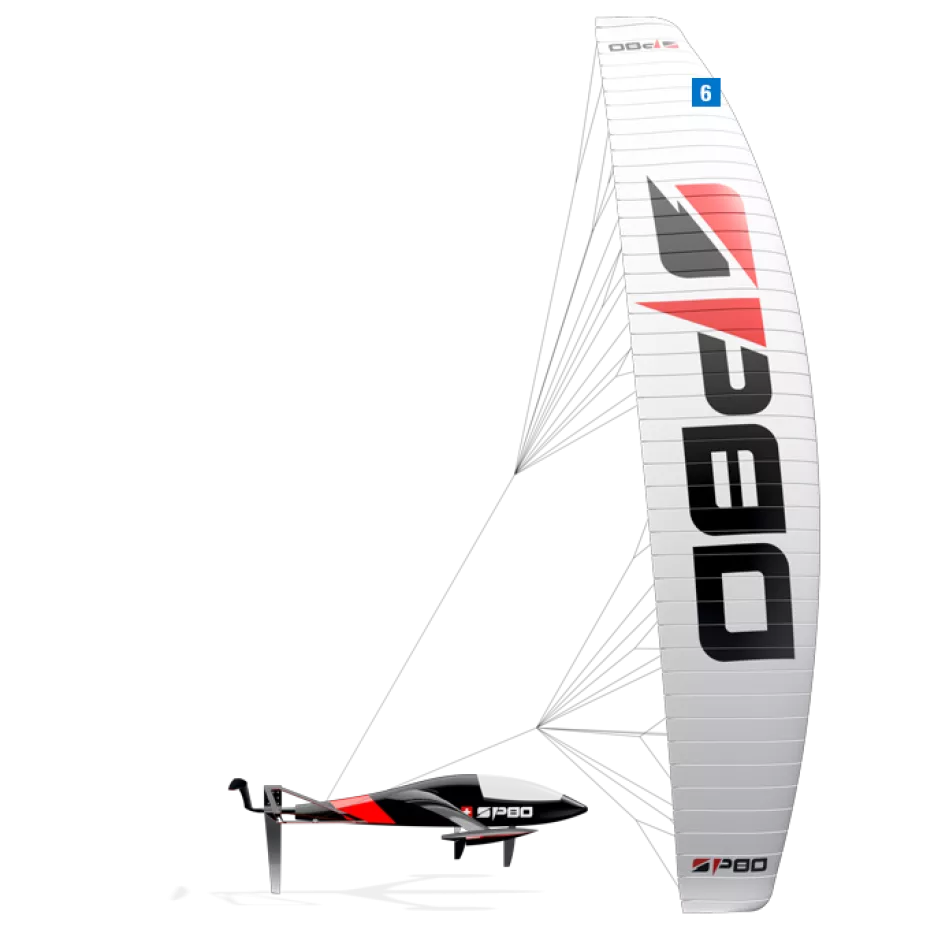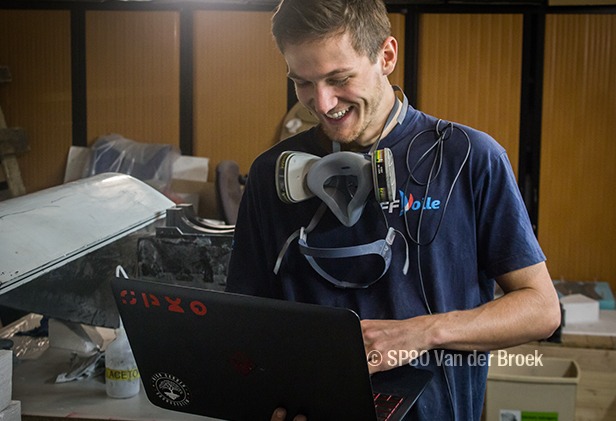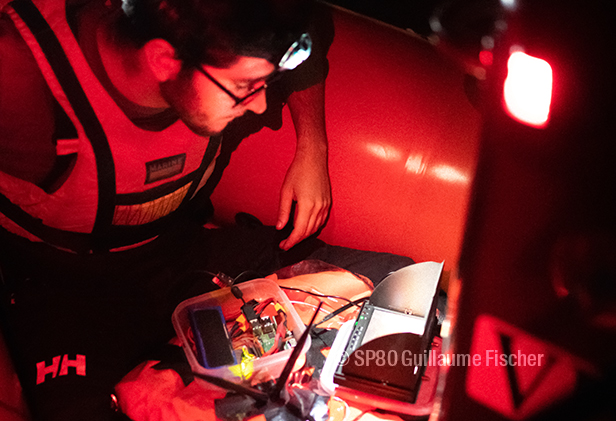At 150 kmph powered by wind only

The sailing speed record has been held for 8 years. A team of students and young engineers is in the process of developing a kiteboat to smash this record in 2022. Projected speed : 80 knots.
At 3.30 a.m. on Lake Geneva in early July, under clear skies the air is fairly warm. Along the shoreline, you can see the lights of the town of Morges.
On board small boats, protected from indiscreet eyes in the halflight of dawn, a dozen young people are intently watching the behaviour of a 4 m long shape, pulled by a Zodiac, cutting smoothly through the dark water. The technical problems revealed during the first test, five nights earlier, have been corrected. This time, the zodiac can accelerate, the shape follows it obediently. Data collected by the sensors confirm the impressions : everything goes according to the simulations.
This is excellent news for the three initiators of these night tests, Mayeul van den Broek, Xavier Lepercq and Benoît Gaudiot. Yet another step towards realising their crazy dream – to beat the world sailing speed record. However, this will have to wait another two years if it all goes as planned. The sun is rising over the Mont-Blanc, unveiling its outline over the south shore of the lake : it is time to return the prototype discreetly into its shed.
Lepercq, van den Broek and Gaudiot were made to meet.
All three are French, sailing lovers and have decided to study engineering. Each of them has chosen the Federal Institute of Technology (EPFL), convinced by its naval competence. The prestigious institute had been a partner to the Swiss syndicate Alinghi (winners of the Americas Cup in 2003 and 2007) and of the “ Hydroptère ” the first large “ flying boat ” (sailing speed record in 2009).
Lepercq was already working and van den Broek finishing his Master’s degree in 2017, when they met Gaudiot, a first-year student. Their complicity was immediate. In the newcomer’s notebook, there were even sketches of kiteboats quite similar to theirs. Moreover, their interests were complimentary : engineering, materials, mechanical design, fluid dynamics… and Gaudiot, as an ex-member of the French national kitesurf team and Under-18 sailing speed record man, could be the ideal test pilot. When chances are all on your side to form a “ dream team ”, you must seize the opportunity. The three men thus decided to work together on a kiteboat project to make their speed world record dream come true. Their eyes riveted on the current record, set in November 2012 on Namibian waters by Paul Larsen. The Australian, at the helm of Vestas Sailrocket 2, beat two confirmed world records : on 500 m at the speed of 65.45 knots (121.06 kmph) and on the nautical mile (1852 m) with 59.37 knots (109.94 kmph). A real sporting feat, given that until then the 50-knot barrier seemed impassable for a vessel without an engine.
Just like the sound barrier, this limit is also dictated by the laws of physics. “ At such speed, water pressure on the keel or the fin drops so rapidly that water starts boiling at ambient temperature ” explains Mayeul van den Broek. “ This change increases drag and makes navigation very unstable – further acceleration becomes impossible. ”
This phenomenon is called cavitation. Its powerful effects can blow into pieces the steel blades of a hydroelectric turbine. Their “ scorch marks ” can also be seen on the fins of tuna fish or dolphins, having paid painfully for their bold desire for speed.
“ Paul Larsen used an innovative super-ventilating fin. This profile is used by hydroplanes, these engine-propelled boats flying at 350 kmph, but was unprecedented in the world of sailing. ” With its triangular shape and straight edges, this fin does not avoid cavitation, but manages to control the disturbing effect. “ At high speed, the air bubbles remain stable ”, explains Benoit Gaudiot, “ there’s no more drag and so it is possible to continue accelerating. ”
For the three friends, this is the key to Larsen’s record, rather than the asymmetrical design of Sailrocket 2 which had attracted full attention so far. They wanted to know for certain, so, in early 2018, they produce super-ventilating fins, in order to become familiar with the technology. They fitted them on a readily available support vessel that they knew well, a kitesurf. After three test runs on the Mediterranean, Gaudiot reached 41 knots (almost 80 kmph). It is a proof of concept: combining a kitsurfing sail and a super-ventilating fin is the winning formula indeed.
This is where the pilot is steering the boat and controls the kite. Since regulations forbid assisted steering, sensors and instruments only provide information to the pilot. They inform him for example if he must immediately drop the kite.
Always on the water, they ensure lateral stability and buffer the impact of waves. They slow down the boat a little bit, but are necessary for the pilot’s comfort.
Strongly curved, it “ anchors ” the boat into the water by opposing its force to the force of the kite, preventing the boat from lateral drag. Its profile is super-ventilated, limiting disturbance from cavitation and enabling the boat to exceed 50 knots.
The boat’s rudder is in an unusually forward position. It also has a super-ventilated profile to control the effects of cavitation.
This is where the flying kite’s cables are attached and that all forces are concentrated. The articulated system ensures passively the balance of forces between kite and fins, conferring power and preventing capsizing.
The prototypes are in the design process. As for kitesurf and paragliding, they should be made of fabric, possibly nylon. Among the available kites (between 20 and 50 m2) the best adapted to wind conditions will be selected. This will also define the cable length (between 40 and 90 m).
However, 41 knots are not fast enough to benefit from the real potential of the super-ventilating fins : 50 knots should be the target speed. “ We needed more power, so a larger kite ” explains van den Broek. A kite that Gaudiot would not be able to hold with his arms. “ This is when we came back to our idea of a boat. ”
Between September 2018 and early 2019 the first concepts were drafted. Their sailing behaviour had to be simulated. As Velocity Prediction Programs (VPP) used by naval architects are too costly, Lepercq spent several months programming their own. As for van den Broek, with his Master’s degree in hand, he spends his time looking for sponsors and developing cooperation with the EPFL.
The VPP confirmed the design’s stability and the project’s feasibility. During the following months, the dream started taking shape. The EPFL recognised the project, gave access to its infrastructures and authorised students to participate in the project as part of their studies. In October 2019, a student association was created, along with the SP80 company, the project owner. The project was officially launched and presented to the public. It was a success: the technical challenge was met, the exciting record-setting race and the spectacular kiteboat could be launched.
With its streamlined 7 m hull, its closed cabin, its “ wings ” fitted with floats and a rear tailplane, the SP80 looks more like a jet than a boat.
Using composite materials, it weighs only 150 kg when empty. At the end of a several-dozen-meter cable, a huge kite – sized between 20 to 50 m2, depending on the needs. The power-to-weight ratio is absolutely amazing, “ never reached before in the world of sailing ! ” highlights van den Broek.
It is so powerful, that the weight of the cabin does not even count in the equation. It doesn’t join the kite in the skies because its curved main hydrofoil “ anchors ” it into the water. These two opposing forces have also been used by Sailrocket 2. “ This avoids capsizing : the stronger the kite pulls, the more the hydrofoil pulls to the opposite side. ”
This permanent balance, created passively, is ensured by what SP80 calls the propulsion module. “ It is the heart of the boat’s power, the place where all the forces are centred. The main idea of our design is to separate the rear module pushing the boat, from the cockpit that ensures the pilot’s stability and security. ”
The design of the propulsion module, both mobile and robust, has taken up most part of the design phase. “ We found solutions that were stable at certain speeds, but not at others. We had to find the best compromise. ” The module being the key element of the boat, SP80 keeps these details confidential.
The design of the kiteboat completed, now it had to be tested in real conditions to prove the VPP simulations. A 1:2-scale prototype was designed and assembled by the students. It was this prototype that the SP80 team took for night testing in early July on Lake Geneva. About ten similar sessions have taken place until October.
Every session, several series of tests are run, returned on land in between, for adjustment and modification. The Zodiac pulls the prototype with a mast, simulating the kite and its cable. On the prototype, an inertial system records speed and acceleration and sensors follow the rotation speed, which is all you need to be able to verify the boat’s behaviour. The sensors are connected by robust IP68 LEMO connectors (K and E series) to the navigation system, collecting the data.
Early morning, the boat’s taken out of the water, dismounted and returned to the SP80 shed, the team analyses the videos and measurements. The aim is to make sure that no element of the boat is overcharged and no unnecessary force is generated. “ For instance, that the immersed part of the rudder is not overloaded ” explains Gaudiot, “ since it is for the pilot to compensate, to be able to steer the boat. ”
Lake Geneva does not offer optimal conditions (still waters, regular strong winds would be necessary to beat the record), but the tests are working out very well. As the design of the kiteboat is finally stabilised, SP80 has now started developing the ultimate boat.
The construction of the boat is scheduled to start early 2021, to be launched at the end of 2021. The world record attempt is planned for 2022.
By a strange coincidence, this agenda corresponds exactly to the plans of Syroco. Co-founded by French kitesurf star Alex Caizergues (the first to exceed 100 kmph in sailing), this startup is also working on a kiteboat designed for beating the record and exceeding the 80 knots. However, competition does not intimidate SP80. “ On the contrary ”, say Gaudiot and van den Broek. “ Why not organise a shared event ? It would be a spectacular “ first ” ! ”
Smashing the current record of 65 knots to exceed 80 would be a great achievement. However, it is not the only objective of SP80 : “ We would like to break codes and make the sailing world progress ! ”
What would be the opportunities for the sophisticated technologies worked out by the team ? After all, super-ventilated fins have existed for decades, but their use has remained confidential. Kiteboats have existed for centuries (the Hawaiian people used them more than 1000 years ago already !). Can they be adapted for larger, heavier vessels ?
Only 10 years ago, highlights Benoit Gaudiot, the sailing world was not at all concerned by 50 knots. Super-ventilated fins - underperforming at lower speed – seemed irrelevant.
“ Today, offshore racing boats – Americas Cup, Route du Rhum… - come regularly close to 50 knots and hit the cavitation barrier. The teams we have consulted are interested in our work. We can imagine that, in 5 to 10 years, their boats could take off the super-ventilating fins when the trade winds are strong and regular, and reinstall them when necessary. ”
Mayeul van den Broek confirms “ there was a big delay between the release of the Hyroptère and the generalisation of “ flying sailing boats ”. It is still hard to tell which applications will be developed, but we expect some opportunities. ”
SP80 – through its main partner P&TS, an intellectual property law firm – has already deposited a patent for the general concept of the boat and the kite. Other patents could follow.











